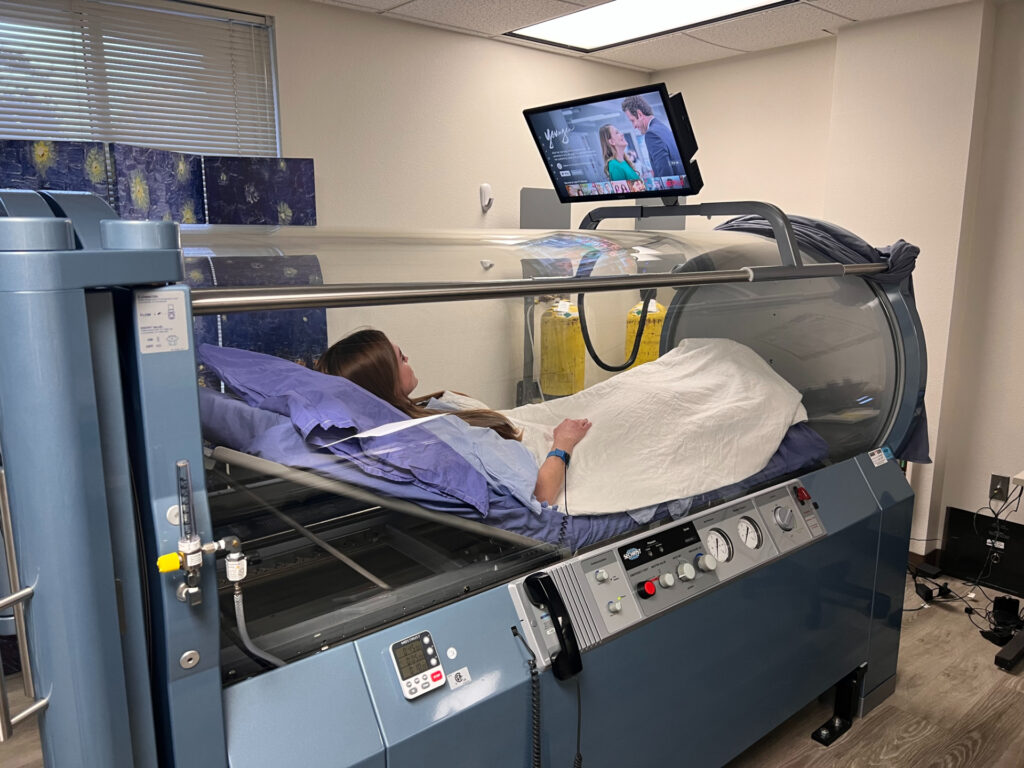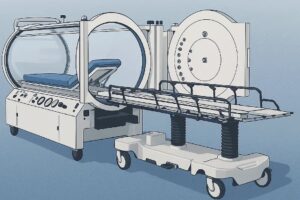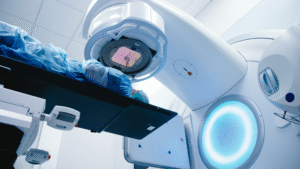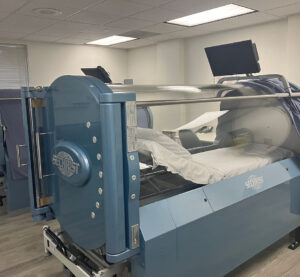Curious about the benefits of hyperbaric oxygen therapy? You’re in the right place. Hyperbaric oxygen therapy (HBOT) is a medical treatment that helps the body heal by breathing 100% pure oxygen in a specialized pressurized chamber. This is different from breathing the air around us, which contains only about 21% oxygen. In an HBOT chamber, the air pressure is increased to two to three times higher than normal, which allows your plasma to dissolve much more oxygen than you can at regular atmospheric pressure.
Oxygen is vital for every cell in your body to function, repair, and fight infection. When tissues are injured—whether due to poor blood flow, surgery, infection, or chronic wounds—they may not get enough oxygen. Without enough oxygen, healing slows down or even stops altogether. HBOT delivers high levels of oxygen directly into the bloodstream and tissues, boosting the body’s natural healing processes.
If you or a loved one has been recommended hyperbaric oxygen therapy (HBOT), here are a few key reasons why oxygen plays such a powerful role in the healing process. When you’re ready to schedule your appointment, give us a call today: (619) 470-4325
Discover the Benefits of Hyperbaric Oxygen Therapy
Stimulates Wound Healing
 HBOT significantly increases the amount of oxygen delivered to tissues that are damaged or deprived of blood flow. This stimulates the growth of new blood vessels (a process called angiogenesis), promotes tissue repair, and enhances the function of fibroblasts and collagen, which are essential for wound care and healing.
HBOT significantly increases the amount of oxygen delivered to tissues that are damaged or deprived of blood flow. This stimulates the growth of new blood vessels (a process called angiogenesis), promotes tissue repair, and enhances the function of fibroblasts and collagen, which are essential for wound care and healing.
According to studies in the National Library of Medicine (NLM), HBOT has been shown to improve outcomes in chronic non-healing wounds, including diabetic foot ulcers and also in alleviating symptoms of radiation-damaged tissue (NIH/NLM, PMID: 30020609).
Reduces Inflammation and Swelling
The pressurized oxygen environment has anti-inflammatory effects. HBOT helps reduce swelling around injured tissues, which improves blood flow and reduces pressure on surrounding structures. This is particularly helpful in conditions like crush injuries and compartment syndrome.
Fights Infection
Oxygen enhances the ability of white blood cells to kill bacteria and prevent infection. It also has direct antibacterial effects against certain harmful microbes, including those that cause gangrene and osteomyelitis (bone infections).
The Undersea and Hyperbaric Medical Society (UHMS) recognizes HBOT as an approved treatment for necrotizing soft tissue infections, which are aggressive, life-threatening infections that spread quickly.
Helps Save Limbs and Prevent Amputation

In patients with diabetic foot ulcers HBOT can help avoid amputation by improving oxygenation in tissues that are otherwise at risk of dying. It can be especially beneficial when other treatments have failed. It is important to have any infection treated and adequate circulation restored to maximize the beneficial effects of hyperbaric oxygen therapy. If blood flow cannot be restored, then the patient may be able to undergo hyperbaric treatment in an effort to save the limb.
Multiple NIH-supported studies have shown that HBOT significantly increases the chance of wound closure and limb salvage in patients with diabetic foot ulcers (PMID: 16820266).
Revives Tissues Damaged by Radiation
Radiation therapy, often used to treat cancer, can damage healthy tissues over time. This may cause problems like radiation cystitis (bladder inflammation) or osteoradionecrosis (bone death). HBOT restores oxygen to these oxygen-starved tissues and promotes new blood vessel growth, helping damaged areas recover.
UHMS-approved indications include late effects of radiation injury, with strong evidence showing HBOT reduces pain and restores function.
Enhances Recovery from Surgery and Skin Grafts
For patients with flap or graft failures, especially when blood supply is limited, HBOT improves oxygen delivery and can salvage compromised tissues. It is also used to enhance healing after cosmetic surgery, reconstructive procedures, or limb reattachments.
Supports Brain and Nerve Healing
Although still being studied, there is growing evidence that HBOT may benefit people with certain neurological conditions, such as traumatic brain injury, stroke, or sudden hearing loss. The therapy may reduce inflammation and promote cellular repair in oxygen-deprived areas of the brain.
The NIH has supported research into HBOT’s role in treating idiopathic sudden sensorineural hearing loss (ISSHL), showing potential for improved hearing recovery when initiated early (PMID: 29425415).
Medical Conditions That Benefit Most from Hyperbaric Oxygen Therapy
According to the Undersea and Hyperbaric Medical Society (UHMS) and the Centers for Medicare & Medicaid Services (CMS), HBOT is approved for 14 specific conditions, including:
- Acute carbon monoxide intoxication
- Decompression illness
- Gas embolism
- Gas gangrene
- Acute traumatic peripheral ischemia (an emergency condition). Hyperbaric oxygen therapy is a valuable adjunctive treatment to be used in combination with accepted standard therapeutic measures when loss of function, limb, or life is threatened.
- Crush injuries and suturing of severed limbs. As in the previous conditions, hyperbaric oxygen therapy would be an adjunctive treatment when loss of function, limb, or life is threatened.
- Progressive necrotizing infections (necrotizing fasciitis)
- Acute peripheral arterial insufficiency (an emergency condition, not to be confused with peripheral artery disease)
- Preparation and preservation of compromised skin grafts (not for primary management of wounds)
- Chronic refractory osteomyelitis, unresponsive to conventional medical and surgical management,
- Osteoradionecrosis as an adjunct to conventional treatment
- Soft tissue radio necrosis as an adjunct to conventional treatment
- Cyanide poisoning
- Actinomycosis, only as an adjunct to conventional therapy when the disease process is refractory to antibiotics and surgical treatment
- Diabetic wounds of the lower extremities in patients who meet the following three criteria:
a. Patient has type I or type II diabetes and has a lower extremity wound that is due to diabetes;
b. Patient has a wound classified as Wagner grade III or higher; and
c. Patient has failed an adequate course of standard wound therapy.
Schedule Your Hyperbaric Oxygen Therapy at HealMedO2
Now that you’re familiar with the many benefits of hyperbaric oxygen therapy, take the next step toward better health. Call us at (619) 470-4325 to schedule your appointment, or visit our contact page to request one online. Our team is here to help you get started on your path to healing.







